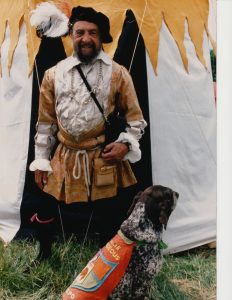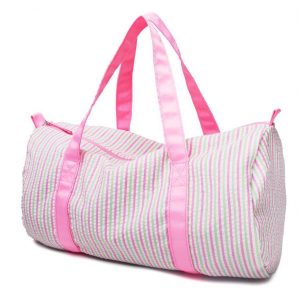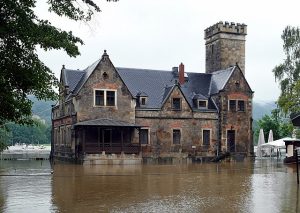Things in the colorful home of my childhood happened in stages–either very rapid or very slow stages. For example, it was not until eight or nine years after we moved into the Barn full time that my parents insulated the interior walls in the living room and hallway–up to that point there was only the exterior walls of the structure between us and the elements–and when the wind swept down the mountain on its way to the valley below, it got frigid. For the first six or seven years that my brother and I slept in “rooms” in one of the former haylofts, they were rooms by courtesy–roughed out 2 x 4 studding to which plasterboard panels would someday be nailed, but no actual walls that stopped anyone or anything from coming in (like, say, cold winds, younger brothers, or bats). On the other hand, when my father decided we needed a trapeze, the thing went up in a matter of days. Priorities, you see.
One of the things which was a lower priority was a finished floor. The floor in the loft was made of plywood sheets. Someday there would be finished floor. But it was not a priority–there were other things that were more interesting to work on (it has only taken me to right now to realize that my father was driven to work on the things that were absolutely necessary or absolutely interesting. Mere flooring in an area he didn’t frequent much was neither of those things).
Sometime when I was in college–Christmas break of my junior year, I think, I decided I needed a finished floor. I told my father so. The family finances were not, at the time, amenable to hiring someone to put in a floor. But we calculated the amount of oak flooring we’d need for my room and the hallway outside, purchased it, and accompanying hardware and tools, and loaded it into the back of the station wagon. When we got home we took out maybe a dozen oak boards and brought them upstairs, and Dad showed me how to install the flooring myself. I think that he got the first row or so settled. Then it was my project. So over the next week I put down the boards–they were tongue-in-groove boards, and were installed using a tool which would set nails at a 45° angle. I could generally get between 1-2 feet width-wise in a day (before the unaccustomed work and my own butterfly tendencies chased me away). For a 10 x 12′ room that made it a 5-6 day job.
A side note: it was December/early January. Rather than moving all the flooring in to the house, I kept it in the back of our station wagon and just went out and got what I needed. One evening I went to visit a friend for dinner. On the way home I got a flat tire. Bless my friend who, when called (I had to hike to the nearest house on the sparsely populated state road, in those pre-cellphone days) got into his warmest work clothes and came to help me change the tire. Of course the spare was in the back of the station wagon which was still half-full of oak flooring. Before Alan got there I had already started removing the boards, trying to put them somewhere where they wouldn’t absorb too much snow–oh, yes, there were snowdrifts, did I mention it? I don’t think we had to completely empty the station wagon before we could access the tire. Eventually, and before I succumbed to frostbite, the tire got changed and I headed for home.
By the time I headed off to college I had a floor of light-oak, unfinished, in my bedroom. But I wanted dark wood. My father had this idea of soaking the wood in automotive oil to change the color, but in the end I settled for a dark stain, which I applied when I came home for the next break. At last: a civilized floor!
Over the next year I finished installing the oak boards in the hallway, starting from the landing and working toward my brother’s room. I don’t recall if we ever hauled a floor sander upstairs–those things are brutally heavy, and there was only a very steep ladder upstairs. But the floor was eventually sealed and done. In later years I twice refinished the existing hardwood floors in the apartments I lived in. So I can add all these experiences (I would not call them skills, just a willingness at the time to do the labor) to the long list of things I can sorta do, if I have to. But if ever I need a floor again, I think I’ll hire someone or do without. Once or twice is a learning experience; more than that is just exhausting.


 When I was a kid we went from our home in New York City to our work-in-progress barn in Massachusetts virtually every weekend. Among other things, this meant that my brother and I got very good at packing. My father had a system for packing, which meant we had packing lessons and were supervised by my father until he was certain that we could be trusted to follow the protocol. All clothes were to be folded and then rolled into neat tubes which could then be stacked in our brightly colored duffels (mine pink, my brother’s, blue). This allowed one to pack an extraordinary amount of stuff–far more than one generally needed for a two-day weekend.
When I was a kid we went from our home in New York City to our work-in-progress barn in Massachusetts virtually every weekend. Among other things, this meant that my brother and I got very good at packing. My father had a system for packing, which meant we had packing lessons and were supervised by my father until he was certain that we could be trusted to follow the protocol. All clothes were to be folded and then rolled into neat tubes which could then be stacked in our brightly colored duffels (mine pink, my brother’s, blue). This allowed one to pack an extraordinary amount of stuff–far more than one generally needed for a two-day weekend. When I was
When I was  Everyone in California is dealing with wildfires right now (along with the pre-existing catastrophes of this stellar year and yes that was sarcastic, 2020 you train wreck) so of course I’m thinking about floods. (I’m thinking about floods, actually, because my friend Kate in Ireland recounted, elsewhere, the epic tale of the back yard drain clogging up and thereby soaking the floor in her mother’s apartment, and…). Kate’s house is built into a hillside, and because gravity works, water runs downhill into the yard and… squish. Wet rug, to say the least.
Everyone in California is dealing with wildfires right now (along with the pre-existing catastrophes of this stellar year and yes that was sarcastic, 2020 you train wreck) so of course I’m thinking about floods. (I’m thinking about floods, actually, because my friend Kate in Ireland recounted, elsewhere, the epic tale of the back yard drain clogging up and thereby soaking the floor in her mother’s apartment, and…). Kate’s house is built into a hillside, and because gravity works, water runs downhill into the yard and… squish. Wet rug, to say the least.